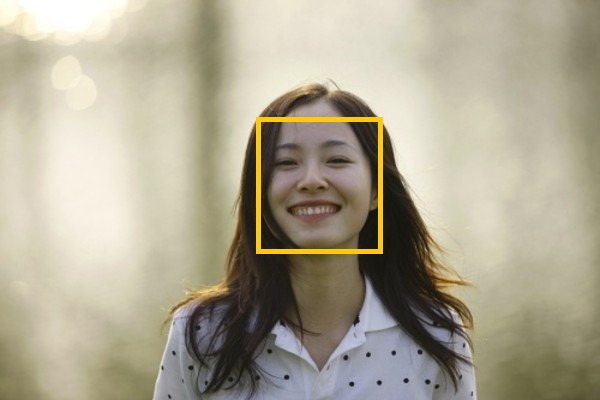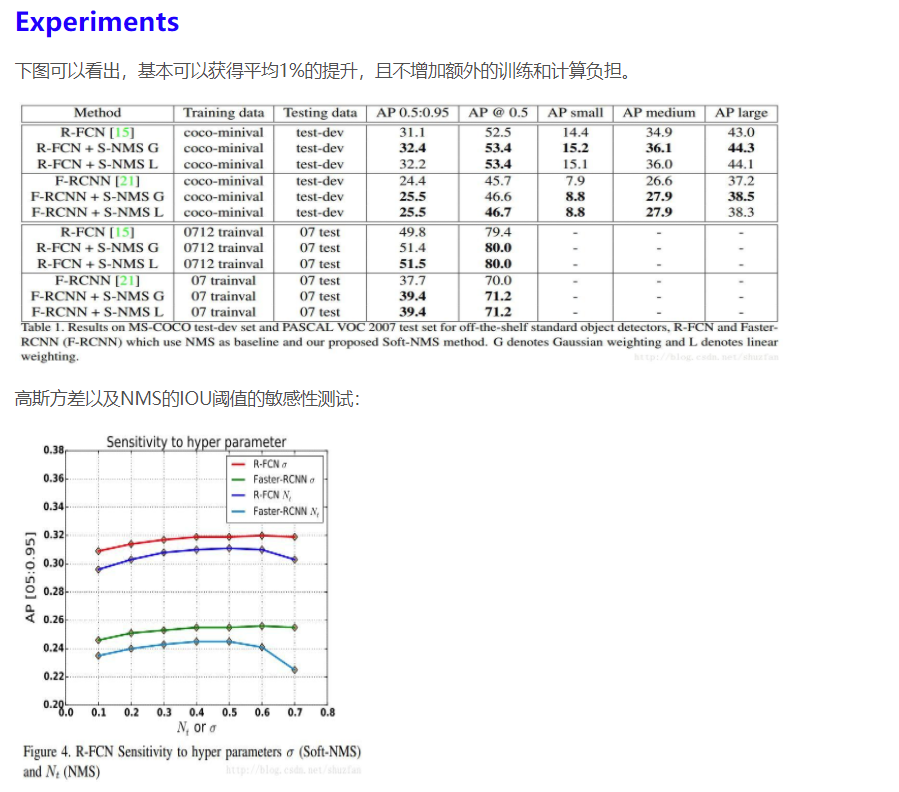非极大值抑制算法(nms)
1. 算法原理
非极大值抑制算法(Non-maximum suppression, NMS)的本质是搜索局部极大值,抑制非极大值元素。
2. 3邻域情况下NMS的实现
3邻域情况下的NMS即判断一维数组I[W]的元素I[i](2<=i<=W-1)是否大于其左邻元素I[i-1]和右邻元素I[i+1],算法流程如下图所示:

a. 算法流程3-5行判断当前元素是否大于其左邻与右邻元素,如符合条件,该元素即为极大值点。对于极大值点I[i],已知I[i]>I[i+1],故无需对i+1位置元素做进一步处理,直接跳至i+2位置,对应算法流程第12行。

b. 若元素I[i]不满足算法流程第3行判断条件,将其右邻I[i+1]作为极大值候选,对应算法流程第7行。采用单调递增的方式向右查找,直至找到满足I[i]>I[i+1]的元素,若i<=W-1,该点即为极大值点,对应算法流程第10-11行。

3. NMS在物体检测中的应用
物体检测中应用NMS算法的主要目的是消除多余(交叉重复)的窗口,找到最佳物体检测位置。


如上图所示,人脸检测中,虽然每个窗口均检测到人脸,但仅需给出一个最有可能表征人脸的窗口
程序整体思路:
先将box中的数据分别存入x1,y1,x2,y2,s中,分别为坐标和置信度,算出每个框的面积,存入area,基于置信度s,从小到达进行排序,做一个while循环,取出置信度最高的,即排序后的最后一个,然后将该框进行保留,存入pick中,然后和其他所有的框进行比对,大于规定阈值就将别的框去掉,并将该置信度最高的框和所有比对过程,大于阈值的框存入suppress,for循环后,将I中满足suppress条件的置为空。直到I为空退出while。
代码(C++):
static void sort(int n, const float* x, int* indices) { // 排序函数(降序排序),排序后进行交换的是indices中的数据 // n:排序总数// x:带排序数// indices:初始为0~n-1数目 int i, j; for (i = 0; i < n; i++) for (j = i + 1; j < n; j++) { if (x[indices[j]] > x[indices[i]]) { //float x_tmp = x[i]; int index_tmp = indices[i]; //x[i] = x[j]; indices[i] = indices[j]; //x[j] = x_tmp; indices[j] = index_tmp; } } }
int nonMaximumSuppression(int numBoxes, const CvPoint *points, const CvPoint *oppositePoints, const float *score, float overlapThreshold, int *numBoxesOut, CvPoint **pointsOut, CvPoint **oppositePointsOut, float **scoreOut) { // numBoxes:窗口数目// points:窗口左上角坐标点// oppositePoints:窗口右下角坐标点 // score:窗口得分// overlapThreshold:重叠阈值控制// numBoxesOut:输出窗口数目 // pointsOut:输出窗口左上角坐标点// oppositePoints:输出窗口右下角坐标点 // scoreOut:输出窗口得分 int i, j, index; float* box_area = (float*)malloc(numBoxes * sizeof(float)); // 定义窗口面积变量并分配空间 int* indices = (int*)malloc(numBoxes * sizeof(int)); // 定义窗口索引并分配空间 int* is_suppressed = (int*)malloc(numBoxes * sizeof(int)); // 定义是否抑制表标志并分配空间 // 初始化indices、is_supperssed、box_area信息 for (i = 0; i < numBoxes; i++) { indices[i] = i; is_suppressed[i] = 0; box_area[i] = (float)( (oppositePoints[i].x - points[i].x + 1) * (oppositePoints[i].y - points[i].y + 1)); } // 对输入窗口按照分数比值进行排序,排序后的编号放在indices中 sort(numBoxes, score, indices); for (i = 0; i < numBoxes; i++) // 循环所有窗口 { if (!is_suppressed[indices[i]]) // 判断窗口是否被抑制 { for (j = i + 1; j < numBoxes; j++) // 循环当前窗口之后的窗口 { if (!is_suppressed[indices[j]]) // 判断窗口是否被抑制 { int x1max = max(points[indices[i]].x, points[indices[j]].x); // 求两个窗口左上角x坐标最大值 int x2min = min(oppositePoints[indices[i]].x, oppositePoints[indices[j]].x); // 求两个窗口右下角x坐标最小值 int y1max = max(points[indices[i]].y, points[indices[j]].y); // 求两个窗口左上角y坐标最大值 int y2min = min(oppositePoints[indices[i]].y, oppositePoints[indices[j]].y); // 求两个窗口右下角y坐标最小值 int overlapWidth = x2min - x1max + 1; // 计算两矩形重叠的宽度 int overlapHeight = y2min - y1max + 1; // 计算两矩形重叠的高度 if (overlapWidth > 0 && overlapHeight > 0) { float overlapPart = (overlapWidth * overlapHeight) / box_area[indices[j]]; // 计算重叠的比率 if (overlapPart > overlapThreshold) // 判断重叠比率是否超过重叠阈值 { is_suppressed[indices[j]] = 1; // 将窗口j标记为抑制 } } } } } } *numBoxesOut = 0; // 初始化输出窗口数目0 for (i = 0; i < numBoxes; i++) { if (!is_suppressed[i]) (*numBoxesOut)++; // 统计输出窗口数目 } *pointsOut = (CvPoint *)malloc((*numBoxesOut) * sizeof(CvPoint)); // 分配输出窗口左上角坐标空间 *oppositePointsOut = (CvPoint *)malloc((*numBoxesOut) * sizeof(CvPoint)); // 分配输出窗口右下角坐标空间 *scoreOut = (float *)malloc((*numBoxesOut) * sizeof(float)); // 分配输出窗口得分空间 index = 0; for (i = 0; i < numBoxes; i++) // 遍历所有输入窗口 { if (!is_suppressed[indices[i]]) // 将未发生抑制的窗口信息保存到输出信息中 { (*pointsOut)[index].x = points[indices[i]].x; (*pointsOut)[index].y = points[indices[i]].y; (*oppositePointsOut)[index].x = oppositePoints[indices[i]].x; (*oppositePointsOut)[index].y = oppositePoints[indices[i]].y; (*scoreOut)[index] = score[indices[i]]; index++; } } free(indices); // 释放indices空间 free(box_area); // 释放box_area空间 free(is_suppressed); // 释放is_suppressed空间 return LATENT_SVM_OK; }
软化非极大值抑制算法(softnms)
参考链接:http://blog.csdn.net/app_12062011/article/details/77963494
Motivation
绝大部分目标检测方法,最后都要用到 NMS-非极大值抑制进行后处理。 通常的做法是将检测框按得分排序,然后保留得分最高的框,同时删除与该框重叠面积大于一定比例的其它框。
这种贪心式方法存在如下图所示的问题: 红色框和绿色框是当前的检测结果,二者的得分分别是0.95和0.80。如果按照传统的NMS进行处理,首先选中得分最高的红色框,然后绿色框就会因为与之重叠面积过大而被删掉。
另一方面,NMS的阈值也不太容易确定,设小了会出现下图的情况(绿色框因为和红色框重叠面积较大而被删掉),设置过高又容易增大误检。
思路:不要粗鲁地删除所有IOU大于阈值的框,而是降低其置信度。
Method
先直接上伪代码,如下图:如文章题目而言,就是用一行代码来替换掉原来的NMS。按照下图整个处理一遍之后,指定一个置信度阈值,然后最后得分大于该阈值的检测框得以保留
原来的NMS可以描述如下:将IOU大于阈值的窗口的得分全部置为0。
文章的改进有两种形式,一种是线性加权的:
一种是高斯加权的:
分析上面的两种改进形式,思想都是:M为当前得分最高框, 为待处理框, 和M的IOU越大, 的得分 就下降的越厉害。
具体地,下面是作者给出的代码:(当然不止一行T_T)
def cpu_soft_nms(np.ndarray[float, ndim=2] boxes, float sigma=0.5, float Nt=0.3, float threshold=0.001, unsigned int method=0): cdef unsigned int N = boxes.shape[0] cdef float iw, ih, box_area cdef float ua cdef int pos = 0 cdef float maxscore = 0 cdef int maxpos = 0 cdef float x1,x2,y1,y2,tx1,tx2,ty1,ty2,ts,area,weight,ov for i in range(N): maxscore = boxes[i, 4] maxpos = i tx1 = boxes[i,0] ty1 = boxes[i,1] tx2 = boxes[i,2] ty2 = boxes[i,3] ts = boxes[i,4] pos = i + 1 # get max box while pos < N: if maxscore < boxes[pos, 4]: maxscore = boxes[pos, 4] maxpos = pos pos = pos + 1 # add max box as a detection boxes[i,0] = boxes[maxpos,0] boxes[i,1] = boxes[maxpos,1] boxes[i,2] = boxes[maxpos,2] boxes[i,3] = boxes[maxpos,3] boxes[i,4] = boxes[maxpos,4] # swap ith box with position of max box boxes[maxpos,0] = tx1 boxes[maxpos,1] = ty1 boxes[maxpos,2] = tx2 boxes[maxpos,3] = ty2 boxes[maxpos,4] = ts tx1 = boxes[i,0] ty1 = boxes[i,1] tx2 = boxes[i,2] ty2 = boxes[i,3] ts = boxes[i,4] pos = i + 1 # NMS iterations, note that N changes if detection boxes fall below threshold while pos < N: x1 = boxes[pos, 0] y1 = boxes[pos, 1] x2 = boxes[pos, 2] y2 = boxes[pos, 3] s = boxes[pos, 4] area = (x2 - x1 + 1) * (y2 - y1 + 1) iw = (min(tx2, x2) - max(tx1, x1) + 1) if iw > 0: ih = (min(ty2, y2) - max(ty1, y1) + 1) if ih > 0: ua = float((tx2 - tx1 + 1) * (ty2 - ty1 + 1) + area - iw * ih) ov = iw * ih / ua #iou between max box and detection box if method == 1: # linear if ov > Nt: weight = 1 - ov else: weight = 1 elif method == 2: # gaussian weight = np.exp(-(ov * ov)/sigma) else: # original NMS if ov > Nt: weight = 0 else: weight = 1 boxes[pos, 4] = weight*boxes[pos, 4] # if box score falls below threshold, discard the box by swapping with last box # update N if boxes[pos, 4] < threshold: boxes[pos,0] = boxes[N-1, 0] boxes[pos,1] = boxes[N-1, 1] boxes[pos,2] = boxes[N-1, 2] boxes[pos,3] = boxes[N-1, 3] boxes[pos,4] = boxes[N-1, 4] N = N - 1 pos = pos - 1 pos = pos + 1 keep = [i for i in range(N)] return keep
这么做的解释如下:

如上图:
假如还检测出了3号框,而我们的最终目标是检测出1号和2号框,并且剔除3号框,原始的nms只会检测出一个1号框并剔除2号框和3号框,而softnms算法可以对1、2、3号检测狂进行置信度排序,可以知道这三个框的置信度从大到小的顺序依次为:1-》2-》3(由于是使用了惩罚,所有可以获得这种大小关系),如果我们再选择了合适的置信度阈值,就可以保留1号和2号,同时剔除3号,实现我们的功能。
但是,这里也有一个问题就是置信度的阈值如何选择,作者在这里依然使用手工设置的值,依然存在很大的局限性,所以该算法依然存在改进的空间。
result:





